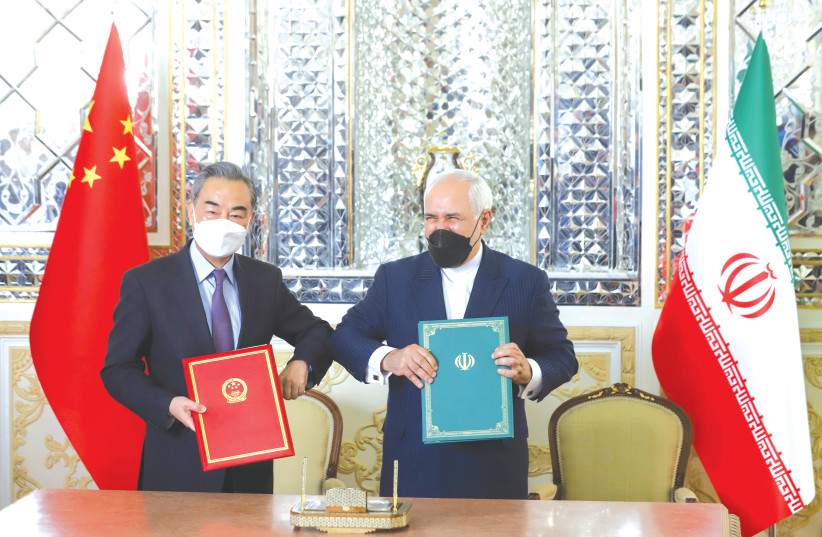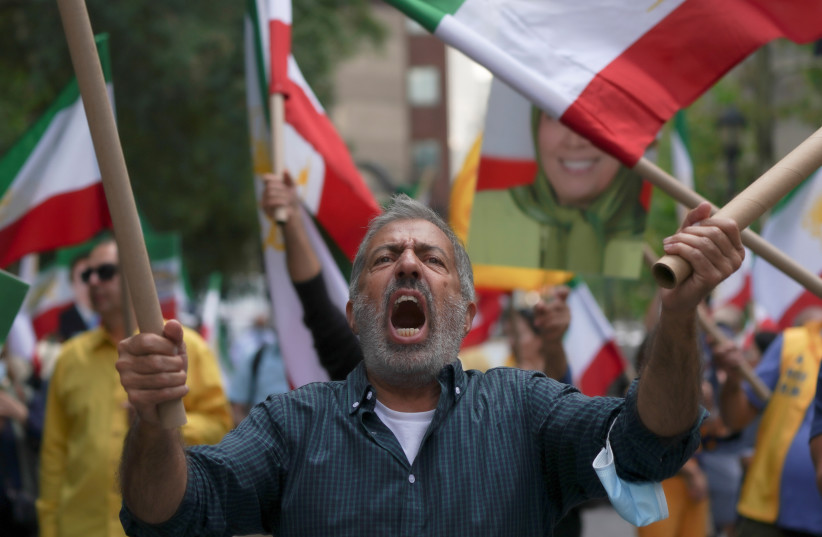As of late Tuesday, Reuters reported that the US and the EU will turn to China to try to get it to reduce its oil purchases from the Islamic Republic.
By YONAH JEREMY BOB
SEPTEMBER 29, 2021 09:38

There is finally a US plan for trying to pressure Iran into coming back to the 2015 JCPOA nuclear deal and to comply with IAEA inspections.
The problem is that the plan is booby-trapped and almost certainly condemned to failure in advance.
As of late Tuesday, Reuters reported that the US and the EU will turn to China to try to get it to reduce its oil purchases from the Islamic Republic.
cnxps.cmd.push(function () { cnxps({ playerId: ’36af7c51-0caf-4741-9824-2c941fc6c17b’ }).render(‘4c4d856e0e6f4e3d808bbc1715e132f6’); });
Recent reports estimate Chinese imports at 553,000 barrels of oil per day for 2021.
Though this is still a far cry from what China was and might be imported if there were no sanctions, it is also enough to keep Tehran on its feet economically and defiant against Western pressure.

At stages where the ayatollahs were more compliant with US and Western wishes, China was importing 0 barrels per day or in the 100,000-200,000 range.
But the chances of Washington convincing Beijing to play ball on a tougher line with Iran at this point are low.
In a September 24 briefing, a Chinese foreign ministry spokesperson put the onus on the United States rather than on Iran, stating: “As the one that started the new round of tensions in the Iranian nuclear situation, the US should redress its wrong policy of maximum pressure on Iran, lift all illegal sanctions on Iran and measures of long-arm jurisdiction on third parties, and work to resume negotiations and achieve outcomes at an early date,” according to a ministry transcript.
It is even possible that the Islamic Republic’s latest move to partially renege on its deal with IAEA Director-General Rafael Grossi came after this Chinese pronouncement with the knowledge of backing from Chinese President Xi Jinping.
Due to the current all-out trade war between Jinping and the Biden administration (as well as the Trump administration before), there is little to no incentive for cooperating with Washington against Tehran.
In fact, the Chinese may even enjoy Iran making further trouble for the US as a way to get concessions in the broader trade war.
During Trump’s term, there were brief periods where Jinping ordered cooperation with the US on Iran issues for a temporary period as long as Trump was operating in a mode of greater cooperation with China.
If the Biden administration were willing to make concessions to Beijing, it is quite possible that it would find more of an ally in pressuring the Islamic Republic.
However, this is an unlikely scenario, as Washington has named China as its number one foreign policy challenge.
Iran is likely seen as a distant third or even lower down priority.
So if Washington is unwilling to give China anything it wants, why would it expect any cooperation on sanctions regarding Iranian oil imports?
Of course, the US can threaten Jinping with harsher sanctions enforcement directly against China, but it is unclear that even that would lead to any short-term concessions.
Often increased pressure from America on China simply leads to an even more tense standoff or mere minor concessions after several months of talks.
The only source of short-term hope in influencing China is the IAEA itself.
Possibly, since the non-political technocrats of the agency are declaring Iran non-cooperative, this could influence China to demand greater Iranian compliance with allowing access to the Karaj nuclear facility which is currently in dispute.
Ironically, this may be Iran’s strategy.
Creating a secondary crisis about Karaj to deflect attention from its continued 60% uranium enrichment and buy it time to conceal other nuclear military activities, so that it can later declare that it is showing “flexibility” by agreeing to access to Karaj – something it already agreed to on September 12.
In the meantime, likely another month or more will have passed of 60% uranium enrichment and possible concealed activities so that if and when full IAEA inspections are restored, the Islamic Republic may have clandestinely achieved many more of its nuclear goals for a breakout to a nuclear weapon at some later point of its choosing.
There is also an outside shot that the ayatollahs may be preparing to announce in the coming weeks or months that they have enough weaponized uranium for a nuclear bomb – though almost no analysts expect this scenario at this time.
Either way, the latest US move to seek help from China after letting Iran spend several months with increasingly dangerous violations of the JCPOA’s nuclear limits and inspections is about as weak a move as Washington could make.
It continues to signal to Tehran that it can stonewall for at least several more weeks, and maybe months before Biden will take stronger action economically, let alone militarily.
If the US announces a new full-court press of sanctions publicly, that would be a different story.
But the China card, as weak as it is being played, for now, is not so different from exposing to the other side in advance that you are bluffing.
Content retrieved from: https://www.jpost.com/international/us-china-iran-triangle-between-a-rock-and-a-hard-place-analysis-680581.